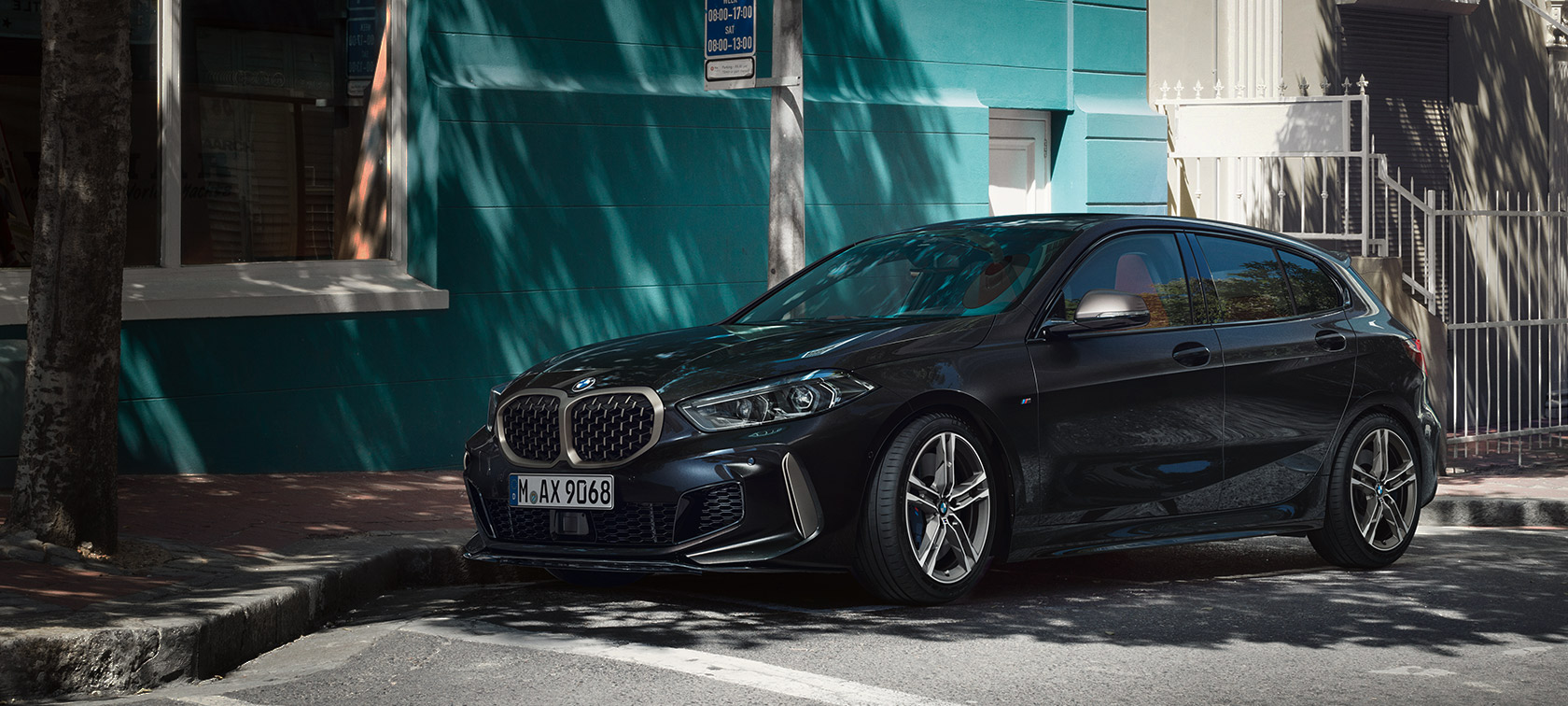Our tool for managing your permission to our use of cookies is temporarily offline. Therefore some functionality is missing.

THE 1
BMW M135i xDRIVE: TECHNICAL DATA.
BMW 1 SERIES M135i xDRIVE: TECHNICAL DATA.
- BMW M135i xDrive
No search result found. Please try another input

| Powertrain type | Petrol |
|---|---|
| Power in kW (hp) | 225 (306) |
| Torque in Nm | 450 |
| Transmission | 8-speed, automatic |
| Drivetrain | All-wheel drive |
| Cylinders | 4 |
|---|---|
| Displacement in cm3 | 1998 |
| Nominal power in kW (hp)/1/min | 225 (306)/5000-6250 |
| Nominal torque in Nm/1/min | 450/1800-4500 |
| Acceleration 0–100 km/h in s | 4.8 |
|---|---|
| Maximum speed in km/h | 250 |
| Fuel consumption, combined in l/100 km | 8.0-7.4 |
|---|---|
| CO2 emissions, combined WLTP in g/km | 180-167 |
| Length/width/height in mm | 4319/1799/1434 |
|---|---|
| Wheelbase in mm | 2670 |
| Curb weight in kg [3] | 1600 |
| Luggage capacity in l | 380-1200 |
| Fuel capacity in l | 50 |
| Optionally delivered with support for trailer load, braked, up to 12%/towbar download in kg | - |
FUEL CONSUMPTION AND CO2 EMISSIONS.
BMW M135i xDrive:
Fuel consumption in l/100 km (combined): 7.9–7.4
CO2 emissions in g/km (combined): 178–168
Official figures for fuel consumption, CO2 emissions, electricity consumption and electric range were determined in accordance with the prescribed measurement procedure and comply with Regulation (EU) 715/2007 as amended. WLTP figures take into account any optional equipment in the case of ranges. For vehicles newly type-approved since 01.01.2021, the official specifications exist only according to WLTP. Further information on the NEDC and WLTP measurement methods can be found at www.bmw.de/wltp
Fuel consumption and CO2 emissions of the BMW M135i xDrive.
BMW M135i xDrive:
Fuel consumption in l/100 km (combined): 7.4
CO2 emissions in g/km (combined): 170
Images show optional equipment, screens and displays depend on equipment options.
The values of fuel consumptions, CO2 emissions and energy consumptions shown were determined according to the European Regulation (EC) 715/2007 in the version applicable at the time of type approval. The figures refer to a vehicle with basic configuration in Germany and the range shown considers optional equipment and the different size of wheels and tyres available on the selected model.
The CO2 efficiency specifications are determined according to Directive 1999/94/EC and the European Regulation in its current version applicable. The values shown are based on the fuel consumption, CO2 values and energy consumptions according to the NEDC cycle for the classification.
For further information about the official fuel consumption and the specific CO2 emission of new passenger cars can be taken out of the „handbook of fuel consumption, the CO2 emission and power consumption of new passenger cars“, which is available at all selling points and at https://www.dat.de/angebote/verlagsprodukte/leitfaden-kraftstoffverbrauch.html.
The figures for performance, consumption and CO2 emissions refer to vehicles with standard transmission.
[1] Performance data of petrol engines apply to vehicles using RON 98 fuel. Fuel consumption data apply to vehicles using reference fuels in accordance with EU Regulation 715/2007. Unleaded RON 91 and higher with a maximum ethanol content of 10% (E10) may also be used. BMW recommends RON 95 fuel. For high-performance automobiles, BMW recommends RON 98 fuel.
[2] Official data for fuel consumption, CO2 emissions, power consumption and electric range was determined in accordance with the prescribed measuring procedure and corresponds to European Regulation (EC) 715/2007 in the applicable version. For ranges, data determined as per WLTP takes into account any optional equipment (available on the German market in this case). For vehicles that have been newly type approved since 1 January 2021, only the official data according to WLTP exists. In addition, NEDC values are deleted from the certificates of conformity as of 1 January 2023 by EC regulation 2022/195.
For more information about NEDC and WLTP measuring procedures visit www.bmw.com/wltp
Further information about fuel consumption and official model-specific CO2 emissions of new passenger cars can be found in the "Guideline for fuel consumption, CO2 emissions and electric power consumption for new passenger cars", available free of charge at all points of sale, at the Deutsche Automobil Treuhand GmbH (DAT), Hellmuth-Hirth-Str. 1, 73760 Ostfildern-Scharnhausen, Germany, and under https://www.dat.de/co2/.
[3] The EC unladen weight refers to a vehicle with standard equipment and does not include any optional extras. The unladen weight includes a 90% full tank and a driver weight of 75 kg. Optional equipment may affect the weight of the vehicle, the payload and the top speed if the selected equipment has an impact on the vehicle's aerodynamics.
Fuel consumption and CO2 emissions of the BMW M135i xDrive.
BMW M135i xDrive:
Fuel consumption in l/100 km (combined): 7.4
CO2 emissions in g/km (combined): 170Images show optional equipment, screens and displays depend on equipment options.
The values of fuel consumptions, CO2 emissions and energy consumptions shown were determined according to the European Regulation (EC) 715/2007 in the version applicable at the time of type approval. The figures refer to a vehicle with basic configuration in Germany and the range shown considers optional equipment and the different size of wheels and tyres available on the selected model.
The CO2 efficiency specifications are determined according to Directive 1999/94/EC and the European Regulation in its current version applicable. The values shown are based on the fuel consumption, CO2 values and energy consumptions according to the NEDC cycle for the classification.
For further information about the official fuel consumption and the specific CO2 emission of new passenger cars can be taken out of the „handbook of fuel consumption, the CO2 emission and power consumption of new passenger cars“, which is available at all selling points and at https://www.dat.de/angebote/verlagsprodukte/leitfaden-kraftstoffverbrauch.html.
